Surfing is more than just riding waves.
It’s about connecting with the ocean and understanding its power and beauty.
As a surfer, you need to develop a deep respect for the sea and learn how to read its moods and rhythms.
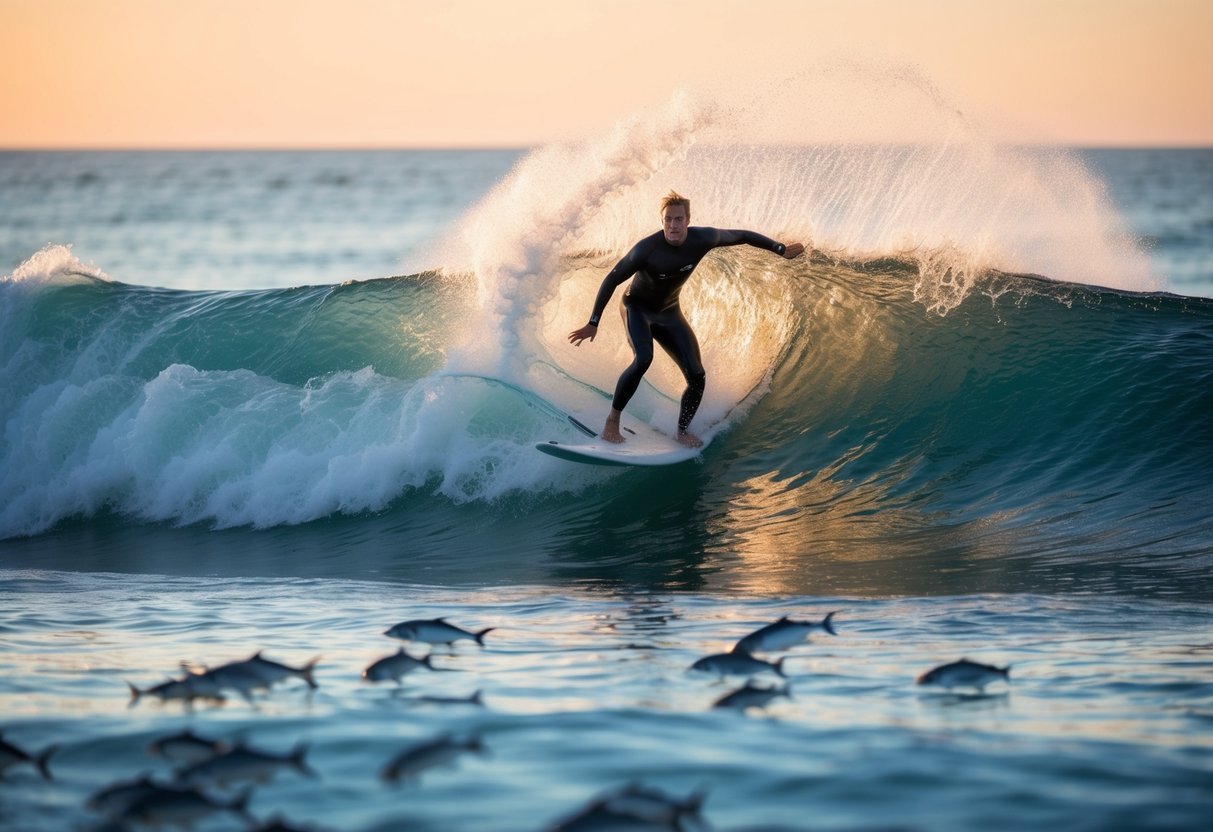
Knowing the essentials about ocean safety and behavior can make your surfing experience safer and more enjoyable. Whether you’re a beginner catching your first waves or an experienced surfer chasing the perfect barrel, there are certain things you should always keep in mind when you paddle out.
Let’s dive into eight crucial aspects of ocean knowledge every surfer should have under their belt.
1) Understand Rip Currents
Rip currents are like nature’s treadmills in the ocean.
They’re powerful channels of water that can pull you away from the shore faster than you can swim against them.
You need to know how to spot these sneaky currents.
Look for areas where the waves aren’t breaking as much as the surrounding water.
These dark gaps in the surf are often telltale signs of a rip current.
If you get caught in one, don’t panic.
Swimming against it will only tire you out.
Instead, swim parallel to the shore until you’re out of the current, then make your way back to land.
As a surfer, you can actually use rip currents to your advantage.
They can give you a free ride to the lineup, saving your energy for catching waves.
But remember, rip currents aren’t just a surfer’s concern.
Keep an eye out for other beachgoers who might not know about them.
You might end up being someone’s hero.
2) Tides Influence Waves
You’ve probably noticed that waves change throughout the day.
That’s because tides significantly affect wave behavior.
Tides are the rise and fall of sea levels caused by the moon and sun’s gravitational pull.
During high tide, you’ll often see bigger waves.
The deeper water allows waves to travel further before breaking.
This can create longer rides and more powerful surf.
Low tide, on the other hand, can make waves break earlier and closer to shore.
It might expose reef breaks or sandbars that weren’t visible before.
This can change the shape and quality of the waves you’re riding.
Did you know that tides can increase wave height by up to 25 percent? That’s a big difference when you’re out there catching waves.
Understanding tide patterns is crucial for picking the best time to surf.
Some spots work better at high tide, while others shine during low tide.
Keep an eye on tide charts and learn how they affect your favorite breaks.
Remember, tides are just one piece of the puzzle.
Wind, swell direction, and bottom contours all play a role in shaping the waves you ride.
But mastering tides will definitely up your surf game.
3) Reading Weather Patterns
Knowing how to read weather patterns is a game-changer for your surfing experience.
You’ll be able to predict when and where the best waves will roll in.
Start by checking out local weather forecasts and surf reports.
These give you a heads up on wind direction, swell size, and potential storm systems.
Pay attention to low-pressure systems, which often bring bigger swells.
High-pressure systems usually mean calmer seas, but can still produce good waves under the right conditions.
Wind direction is crucial.
Offshore winds (blowing from land to sea) create cleaner, more defined waves.
Onshore winds tend to make choppy, less ideal surf conditions.
Keep an eye on storm patterns too.
A distant storm can generate awesome swells without the messy local weather.
Don’t forget about tides.
They affect wave quality and can make or break your session.
Learning to read tide charts will help you time your surf perfectly.
With practice, you’ll start to connect the dots between weather patterns and great surf days.
It’s like having a secret map to the best waves!
4) Types of Surf Breaks
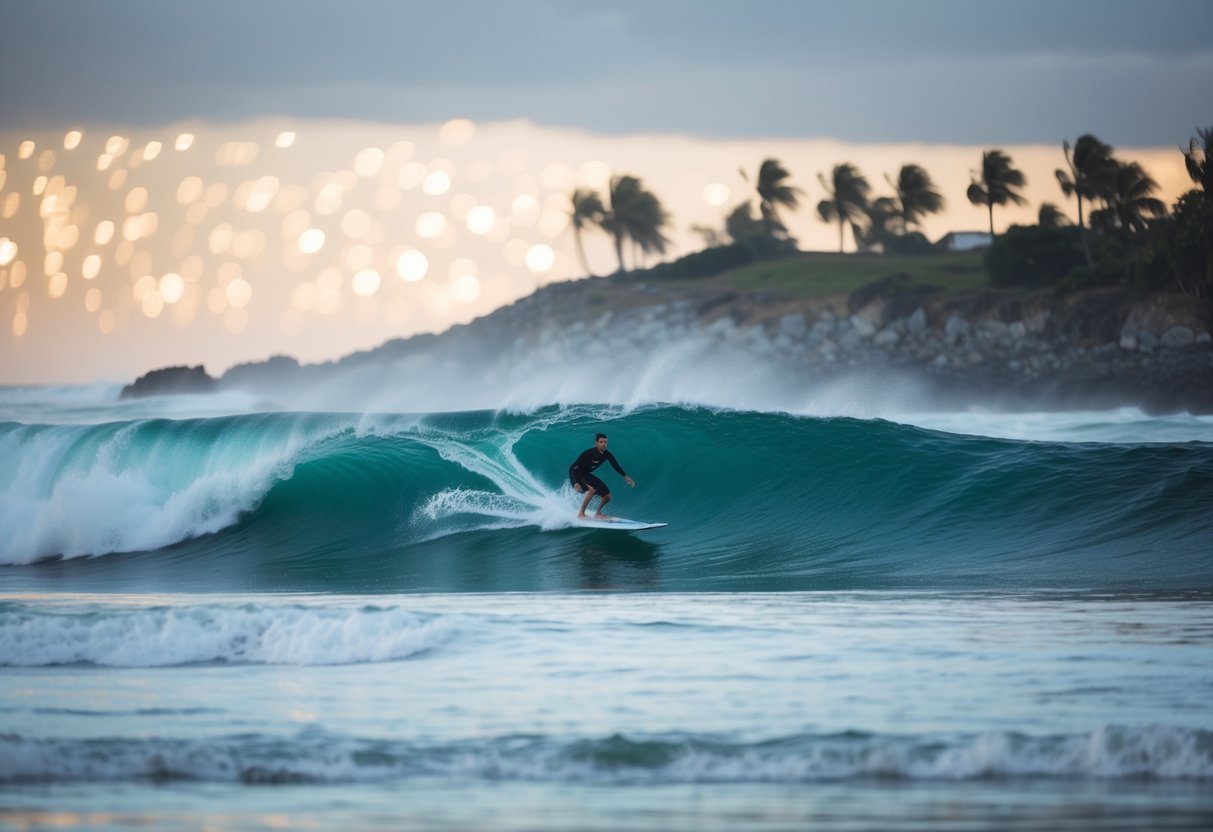
Knowing the different types of surf breaks is crucial for your surfing adventures.
Each break offers a unique experience and challenge.
Beach breaks occur when waves hit sandbars near the shore.
These are great for beginners and can be found at many popular surf spots.
Reef breaks happen when waves break over coral or rocky reefs.
They often create powerful, hollow waves that more experienced surfers love.
Point breaks form when waves wrap around a point of land.
These can provide long, consistent rides that are a dream for many surfers.
You’ll also encounter river mouth breaks where rivers meet the ocean.
These spots can offer fun waves due to the interaction of currents and sand deposits.
Jetty breaks occur near man-made structures like piers or jetties.
They can create interesting wave patterns and are often less crowded.
Understanding these different breaks will help you choose the right spot for your skill level and desired surf experience.
Remember, each break has its own personality and challenges.
5) Marine Life Awareness
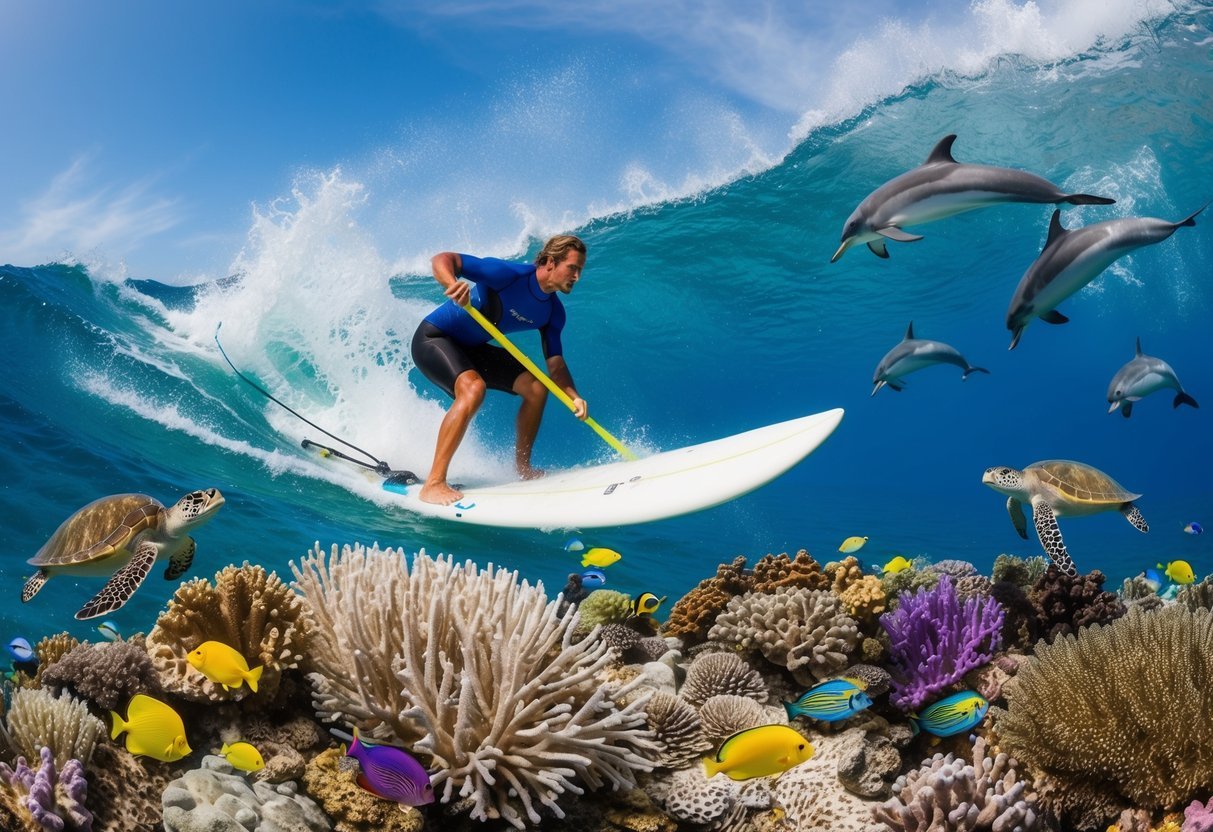
As a surfer, you’re not just riding waves – you’re sharing the ocean with countless marine creatures.
It’s crucial to know what’s swimming beneath your board.
The ocean is home to an incredible variety of life.
Two-thirds of all marine species remain unidentified, so there’s always something new to discover.
When you’re out catching waves, keep an eye out for local marine life.
You might spot dolphins, seals, or even whales if you’re lucky.
Remember, you’re in their home, so respect their space.
Be aware of potentially dangerous creatures too.
Sharks, jellyfish, and stingrays might be in the area.
Don’t panic – attacks are rare, but it’s good to know what to do if you encounter them.
Avoid stepping on the ocean floor when possible.
You could accidentally harm bottom-dwelling creatures or disturb their habitats.
Plus, you’ll steer clear of any hidden stingrays.
Consider getting involved with ocean conservation efforts.
Many surfing communities organize beach cleanups or support marine protection initiatives.
It’s a great way to give back to the ocean that gives you so much stoke.
6) Ocean Conservation Tips

As a surfer, you’re in a unique position to help protect the oceans you love.
Wearing reef-safe sunscreen is a simple yet effective way to reduce harm to marine ecosystems.
When you’re at the beach, make it a habit to pick up trash you see.
Even small actions like this can have a big impact on ocean health.
Be mindful of your plastic use.
Say no to single-use plastics and opt for reusable water bottles and food containers when you hit the waves.
Respect wildlife by keeping your distance from marine animals and never touching or feeding them.
Remember, you’re a guest in their home.
Support local and global ocean conservation efforts.
You can volunteer, donate, or spread awareness about organizations working to protect our seas.
Consider joining surf-focused environmental groups that combine your passion for riding waves with ocean advocacy.
7) Dangers of Shore Breaks
Shore breaks are no joke.
These waves can pack a serious punch, breaking right on the beach with little warning.
They’re known for causing injuries to surfers and swimmers alike.
The main risk? Getting slammed onto the sea floor.
It’s not just about wiping out – you could end up with broken bones or worse.
Shore breaks are especially tricky because they can look deceptively small.
Don’t be fooled by their size.
Even waves as small as 3 feet can cause spinal injuries.
That’s because there’s often a sudden depth change near the shore, making the waves break with extra force.
If you’re caught in a shore break, your best bet is to dive through the wave before it breaks.
Turn sideways, drop your shoulder, and push off the bottom if you can.
Remember, shore breaks can be more dangerous in some places than others.
Always check local conditions and heed warnings.
It’s better to sit one out than risk a serious injury.
8) Identifying Safe Surf Spots
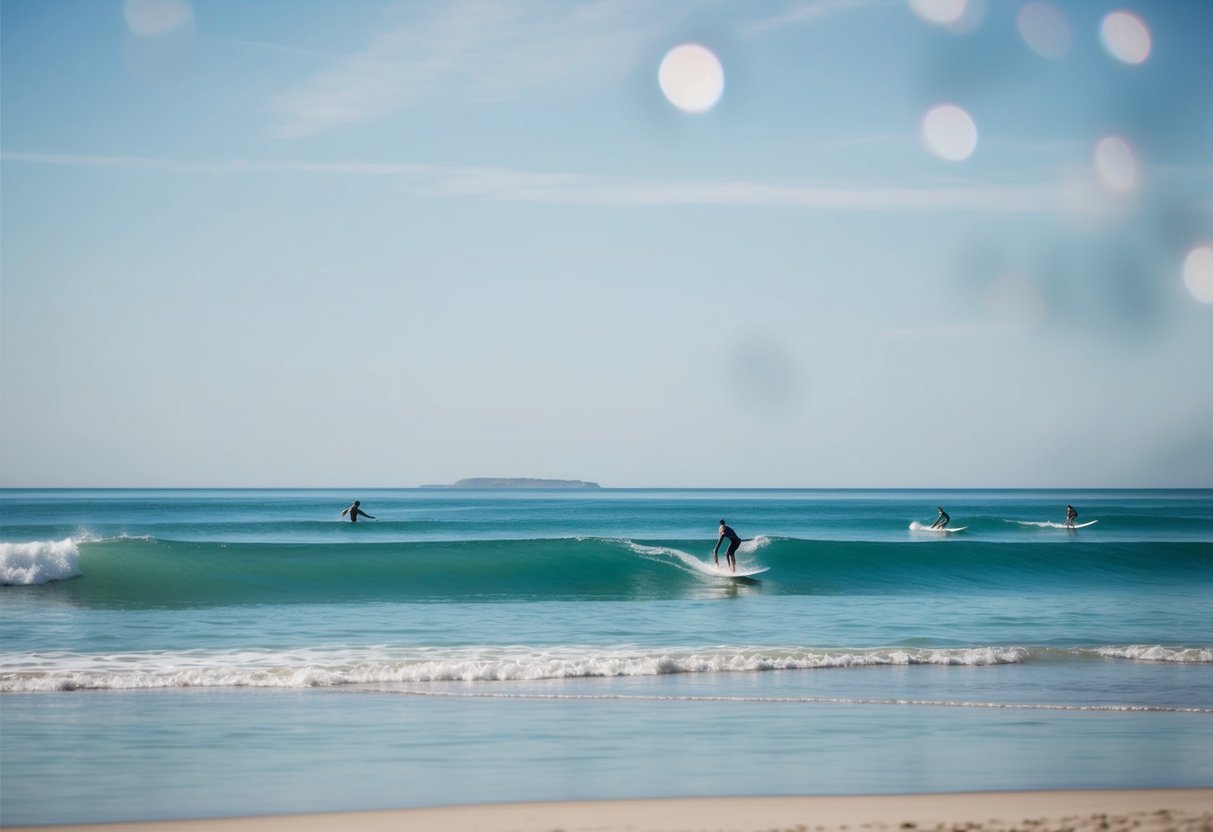
Picking the right spot to catch waves is crucial for your safety and enjoyment.
Before paddling out, take a few minutes to observe the ocean and beach conditions.
Look for areas with consistent wave patterns and fewer hazards like rocks or strong currents.
Proper surf etiquette is also key to staying safe in crowded lineups.
Check for any warning flags or signs posted on the beach.
Different colored flags often indicate specific hazards or conditions you should be aware of.
Rip currents can be dangerous, so learn to spot them.
Look for areas where waves aren’t breaking or where there’s a visible channel of choppy, darker water moving seaward.
If you’re new to a spot, chat with local surfers or lifeguards.
They can provide valuable insights about hidden dangers or the best areas to surf.
Pay attention to the tide.
Some spots are safer at high tide, while others work better at low tide.
Always check the tide charts before heading out.
Remember, conditions can change quickly.
Keep an eye on the weather and be prepared to head in if things take a turn for the worse.
Understanding Ocean Currents
Ocean currents shape the surfing experience.
They affect wave formation, ride quality, and safety in the water.
Knowing how to identify and work with currents can take your surfing to the next level.
Impact on Surfing Conditions
Ocean currents play a huge role in how waves form and break. Lateral currents can push you sideways as you paddle out, making it harder to reach the lineup.
But they can also help you conserve energy if you use them right.
Some currents create better waves by organizing swells.
Others might mess up the surf by chopping up the water’s surface.
Rip currents can actually help you get out past the breakers faster, but they’re also dangerous if you don’t know what you’re doing.
Pay attention to how currents affect wave shape.
They can make waves steeper, hollower, or more mellow depending on their direction and strength.
How to Spot Different Currents
Spotting currents before you paddle out is key.
Look for areas where the water’s surface looks different.
Rip currents often appear as darker, calmer channels between breaking waves.
Watch for seaweed or debris moving in a specific direction.
This can clue you in to surface currents.
Foam patterns on the water can also reveal current flow.
Check the flags at lifeguard stations.
They often indicate current directions and strengths.
Talk to local surfers or lifeguards about typical current patterns at the beach.
Remember, currents can change with the tides.
What works at low tide might be totally different at high tide.
Always reassess conditions throughout your session.
Marine Life Awareness
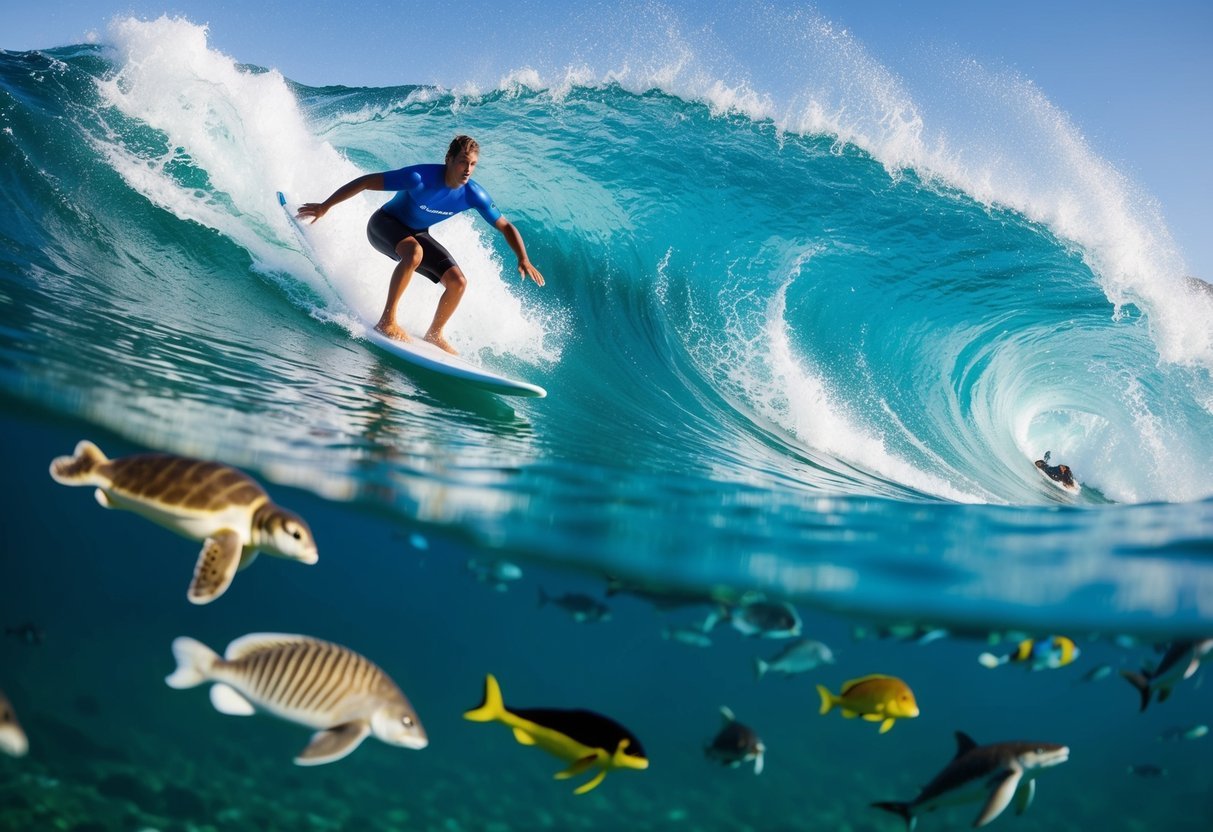
Surfing brings you up close with fascinating ocean creatures.
Knowing what you might encounter and how to interact respectfully enhances your surfing experience while protecting marine ecosystems.
Common Sea Creatures Near Surf Spots
You’ll likely spot dolphins and seals frolicking in the waves at many surf spots.
These playful mammals often approach surfers out of curiosity.
Colorful fish darting beneath your board are another common sight.
In tropical areas, you might glimpse sea turtles gliding by.
Be careful not to disturb them if they’re nesting on the beach.
Jellyfish can sometimes drift into surf zones – learn to identify local species to avoid painful stings.
Sharks, while rare, occasionally visit surf spots.
Most aren’t interested in humans, but it’s wise to exit the water if you spot one.
Familiarize yourself with local shark species and any warnings or protocols at your surf spot.
Respecting Wildlife While Surfing
When surfing, you’re a guest in the ocean’s habitat.
Give marine animals plenty of space and avoid touching or chasing them.
This reduces stress on wildlife and keeps you safe from potential defensive reactions.
Never turn your back on the ocean – not just for your safety, but to stay aware of approaching wildlife.
If animals seem agitated by your presence, it’s best to paddle away calmly.
Be mindful of fragile ecosystems like coral reefs.
Avoid stepping on or touching coral, as this can damage these vital habitats.
Pick up any trash you see in the water or on the beach to protect marine life from harmful debris.
Frequently Asked Questions
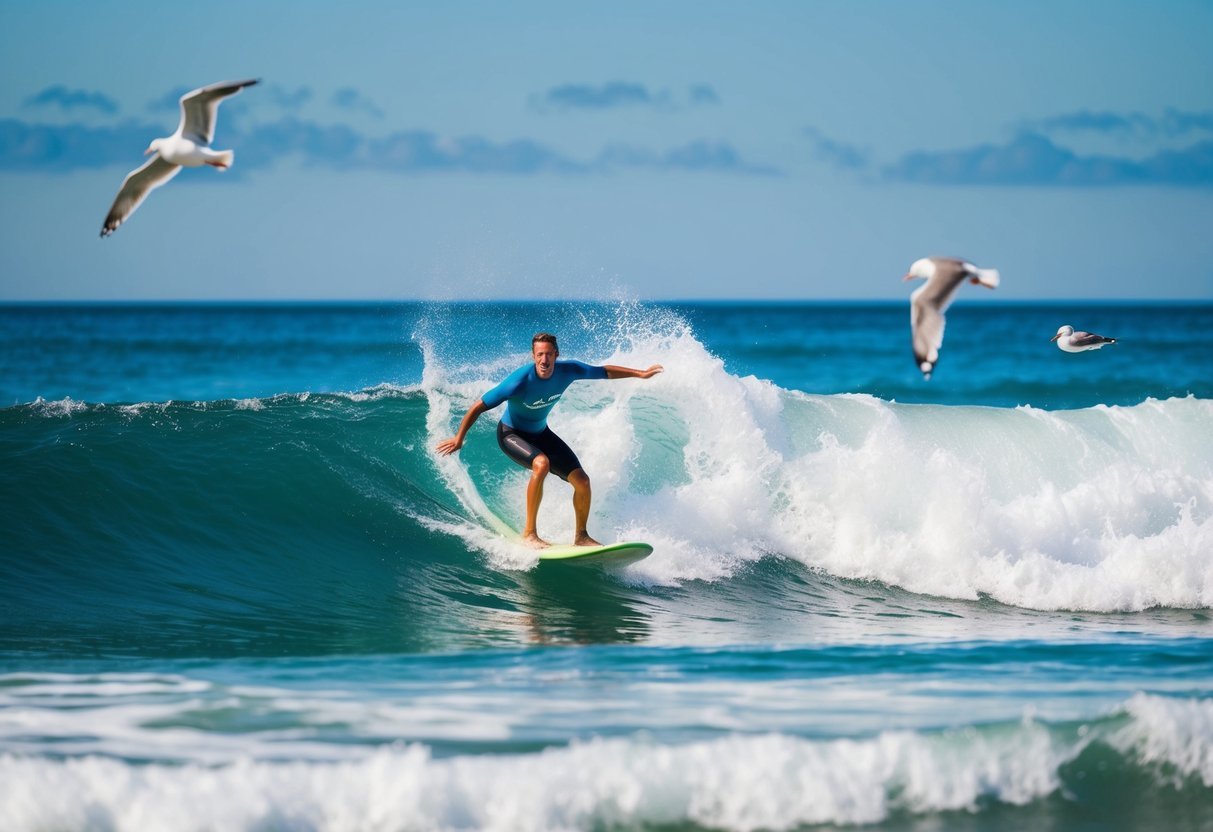
Surfing involves understanding the ocean’s complex dynamics.
Here are some key things to know about waves, forecasts, safety, and more.
What makes a wave surfable?
A surfable wave has the right shape and speed.
You need a wave that’s not too steep or flat, with enough power to propel you forward.
The best waves usually break in water that’s about 1.3 times deeper than the wave height.
How do you read the surf forecast?
Reading a surf forecast takes practice.
You’ll want to check wave height, period, direction, and wind conditions. Wave period is especially important – longer periods usually mean better-quality waves.
Can you surf in any ocean?
Technically, you can surf wherever there are waves.
But some spots are better than others.
Coastal areas with consistent swells and favorable wind patterns make for the best surfing locations.
What’s the best way to avoid a shark attack while surfing?
Shark attacks are rare, but it’s smart to be cautious.
Avoid surfing at dawn, dusk, or night when sharks are most active.
Stay away from areas with seals or fishing activity.
If you spot a shark, calmly paddle to shore.
How do you know if the tide is right for surfing?
Different breaks work best at different tide levels. Tides affect wave shape and power.
Generally, a rising mid-tide often provides good conditions.
Check local tide charts and ask experienced surfers about specific spots.
What should you do if you get caught in a rip current?
If you get caught in a rip, don’t panic.
Swim parallel to the shore until you’re out of the current, then swim back in.
If you can’t make progress, float and wave for help.
Never try to swim directly against a rip current.


